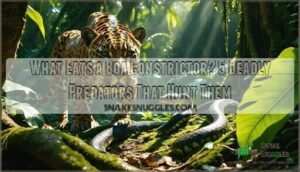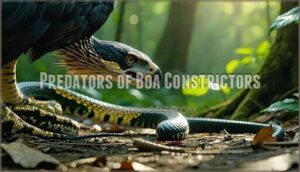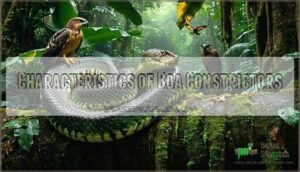This site is supported by our readers. We may earn a commission, at no cost to you, if you purchase through links.

Several dangerous enemies actively hunt these powerful snakes, especially when they’re young and vulnerable. Large birds of prey like hawks can snatch smaller boas from trees, while caimans and alligators pose serious threats to adults near water sources.
Other snakes, monitor lizards, and even jaguars occasionally target boas as meals. Young boa constrictors face the highest risk since they can’t defend themselves like adults can.
It’s nature’s classic game of predator versus predator, where size and timing determine who becomes dinner and who walks away victorious, a situation that is a classic game.
Table Of Contents
- Key Takeaways
- What Eats a Boa Constrictor?
- Predators of Boa Constrictors
- Airborne Enemies
- Water-Faring Enemies
- Human Threats
- Characteristics of Boa Constrictors
- Frequently Asked Questions (FAQs)
- What animal can eat a boa constrictor?
- What are common boas predators?
- Do jaguars eat boa constrictors?
- What does a boa constrictor eat in the rainforest?
- What eats a boa constrictor in the rainforest?
- What is the natural prey of the boa constrictor?
- How does a boa constrictor protect itself from predators?
- How do boa constrictors avoid being eaten?
- Can other snakes prey on boa constrictors?
- Are there any insect predators of boa constrictors?
- Conclusion
Key Takeaways
- You’ll find that young boa constrictors face the highest risk, with hawks swooping down to snatch smaller boas from trees while larger predators like jaguars and caimans target adults near water sources.
- You should know that water-dwelling enemies pose serious threats, as caimans and alligators use crushing bite forces exceeding 1,000 pounds per square inch to overpower boas crossing waterways or hunting near rivers.
- You can’t overlook that aerial predators dominate the skies, with hawks and eagles using high-speed diving attacks at 150+ kilometers per hour to target vulnerable boas during daylight hours.
- You must understand that humans represent the greatest danger through habitat destruction, illegal hunting for valuable skins, and the exotic pet trade that removes thousands of boas from their natural environments annually.
What Eats a Boa Constrictor?
Even mighty boa constrictors aren’t at the top of the food chain. These impressive snake predators face threats from animals that eat snakes throughout their lives, with juvenile vulnerability being particularly high.
Hawks target young boas from above, while caimans and alligators attack with bone-crushing jaws in shared waterways. Large snake predators like anacondas also pose threats to smaller boas.
Humans remain the greatest danger through habitat destruction, hunting for valuable skins, and conflicts with farmers. Invasive boas face additional persecution when they disrupt local ecosystems.
The conservation status of these serpents depends largely on protecting their predator habitats and managing human-wildlife conflicts. Understanding what threatens these boa constrictor predators helps us appreciate their complex role in nature’s balance, where even apex predators must constantly watch for danger.
Predators of Boa Constrictors
You might think boa constrictors are untouchable predators, but they’re actually on the menu for several dangerous animals that can overpower these impressive snakes.
From sharp-taloned hawks swooping down on younger boas to powerful caimans delivering crushing bites, these constrictors face real threats that can turn them from hunter to hunted in seconds.
Hawks
When you’re observing hawk hunting tactics, you’ll notice these flying predators target vulnerable young boas with precision strikes.
Hawk species involved include roadside hawks that swoop down using sharp talons. Juvenile boa vulnerability peaks during daylight hours when boa defense efficacy proves limited against aerial attacks.
This predation substantially impacts boa constrictor predators dynamics, demonstrating how snake predators and animals that eat snakes shape ecosystem impact through natural selection pressures.
The US Fish and Wildlife Service proposed listing the boa constrictor as an injurious wildlife species under the Lacey Act.
Caimans
Throughout South America’s wetlands, caimans represent one of nature’s most formidable boa constrictor predators.
In South America’s murky waters, caimans lurk as silent death machines, turning mighty boa constrictors into their next meal.
These semi-aquatic reptiles demonstrate remarkable caiman behavior when hunting snakes, using their powerful jaws and stealth tactics. Understanding this predator prey relationship reveals how caiman size and habitat overlap create deadly encounters.
Jaguars also thrive in these wetlands, where jaguars hunt caimans.
Key caiman predation strategies include:
- Ambush attacks from murky waters
- Crushing bite force exceeding 1,000 pounds per square inch
- Opportunistic timing during snake water crossings
Alligators
When alligators encounter boa constrictors in Florida swamps, size determines the outcome.
Large alligators easily overpower smaller boas with their crushing bite force, while juvenile gators avoid adult constrictors.
These aquatic enemies from the Crocodilia order share overlapping habitats, creating natural predator-prey dynamics.
Alligator behavior includes opportunistic hunting, making unsuspecting boas vulnerable near waterways.
Airborne Enemies
Above the canopy, aerial threats lurk with deadly precision.
Hawks and eagles dominate the skies as formidable birds of prey, using their exceptional eyesight to spot vulnerable targets below.
These airborne hunters exploit juvenile vulnerability, targeting young boa constrictors during their most defenseless moments. Hawk hunting involves high-speed diving attacks that can exceed 150 kilometers per hour.
Their sharp talons pierce through snake scales with surgical accuracy, while their powerful wingspans create devastating surprise attacks. Eagle predation proves equally lethal, with harpy eagles and wedge-tailed eagles actively pursuing smaller boas.
Bird attacks typically occur when snakes bask in open areas or move between hiding spots. Young constrictors face the highest risk, as their size makes them perfect prey for these sky-bound predators who’ve mastered the art of aerial ambush.
Water-Faring Enemies
When you think of dangerous waters, caiman predation should top your list of concerns for boa constrictors.
These prehistoric-looking hunters dominate river ecosystems throughout the Amazon, using stealth and crushing power to ambush unsuspecting snakes.
Young boas crossing waterways face serious coastal threats from white-bellied sea eagles patrolling above.
Alligator attacks in places like Florida’s Everglades prove equally devastating.
These massive reptiles can overpower even adult boas with bone-crushing bites.
Crocodiles in brackish aquatic habitats add another layer of danger, especially during flooding seasons when boas must navigate treacherous waters.
Unlike the swift strikes from above, water-based predators rely on patience and ambush tactics.
They’ll wait motionless for hours, then explode into action when a boa ventures too close.
Even jaguars, excellent swimmers themselves, hunt boas near riverbanks where escape routes become limited.
Human Threats
While wild predators pose real dangers to boa constrictors, humans represent their greatest threat by far.
While jaguars and caimans are formidable foes, it’s humans who pose the deadliest threat to these powerful serpents.
You might think snakes this powerful would be safe from us, but our impact devastates their populations in ways that go far beyond simple hunting.
Here’s how humans threaten these impressive reptiles:
- Habitat Destruction – We clear forests for agriculture and development, destroying the homes boas need to survive and hunt effectively.
- Illegal Hunting – Fashion industries prize boa skins for luxury boots and handbags, driving systematic capture of wild populations.
- Pet Trade – The exotic pets market removes thousands of boas from their natural environments annually, disrupting local ecosystems.
- Human Encroachment – As we expand into snake territories, farmers often kill boas they consider threats to livestock, while eradication programs target them as invasive species in some regions.
Young boas face the highest risk from these human activities, making habitat protection absolutely critical for species survival. Understanding snake ownership regulations is essential for conservation efforts.
Characteristics of Boa Constrictors
Beyond human threats, understanding boa constrictors helps explain why they face so many predators.
These remarkable snakes call Central and South America home, where they’ve mastered survival through impressive adaptations.
Boa constrictors grow massive, reaching 13 feet and weighing up to 60 pounds.
Their lifespan spans 20-30 years in wild habitat conditions.
Unlike venomous snakes, they’re ambush hunters using constriction to subdue prey.
| Characteristic | Details |
|---|---|
| Boa Size | Up to 13 feet long, 60+ pounds |
| Lifespan | 20-30 years in the wild |
| Diet | Rodents, birds, mammals (changes with age) |
| Reproduction | Ovoviviparous, 60 live young per litter |
| Habitat | Tropical forests, grasslands of Central/South America |
Their boa constrictor diet shifts dramatically with age.
Young boas eat small prey like frogs, while adults tackle deer-sized mammals.
After gorging themselves, they’ll fast for weeks.
This feast-or-famine lifestyle makes them vulnerable when snake natural enemies strike during digestion periods.
Frequently Asked Questions (FAQs)
What animal can eat a boa constrictor?
Picture yourself hiking through dense jungle when you spot movement above.
That’s when you’d realize jaguars, eagles, caimans, and even other large snakes like anacondas can overpower and eat boa constrictors.
What are common boas predators?
You’ll find jaguars, caimans, and large birds of prey like eagles hunting adult boas. Hawks target younger snakes, while humans remain their biggest threat through habitat destruction and hunting.
Do jaguars eat boa constrictors?
Like a silent shadow stalking through the jungle, you’ll find that jaguars absolutely hunt and eat boa constrictors.
These powerful cats are one of the snake’s primary mammalian predators in their shared South American habitat.
What does a boa constrictor eat in the rainforest?
You’ll find boa constrictors in rainforests hunting rodents, birds, lizards, and frogs.
They’ll also grab bats, squirrels, and small mammals when opportunity strikes, using their heat-sensing pits to locate warm-blooded prey, which makes them skilled at catching a variety of warm-blooded animals.
What eats a boa constrictor in the rainforest?
You’ll find jaguars, caimans, and large birds of prey hunting boa constrictors in rainforests.
Hawks target young boas, while crocodiles and other large snakes pose threats.
Humans remain their biggest predator through habitat destruction.
What is the natural prey of the boa constrictor?
You’ll find boa constrictors hunting rodents, birds, lizards, and small mammals like rabbits and bats. They’re opportunistic feeders who’ll grab fish, frogs, and even other snakes when available.
How does a boa constrictor protect itself from predators?
The best defense is a good offense, they say.
When you’re threatened, you’ll camouflage yourself expertly, hiss loudly as warning, release foul-smelling musk, then bite with powerful jaws if predators don’t back down immediately.
How do boa constrictors avoid being eaten?
Boa constrictors blend seamlessly into their surroundings using natural camouflage, hiss loudly when threatened, and release foul-smelling musk to deter attackers.
If cornered, they’ll deliver powerful bites while staying perfectly still to avoid detection.
Can other snakes prey on boa constrictors?
Yes, you’ll find larger snake species like anacondas can prey on smaller or younger boa constrictors. Interspecies snake predation happens frequently in competitive environments where size advantages determine survival outcomes.
Are there any insect predators of boa constrictors?
Picture tiny David facing Goliath—that’s exactly what happens in nature’s surprising matchups.
Large spiders can actually attack and kill juvenile boa constrictors, proving that size isn’t everything when you’re dealing with venomous predators.
Conclusion
Surprisingly, young boa constrictors face a 60% mortality rate in their first year due to predation.
Understanding what eats a boa constrictor reveals nature’s intricate balance where even apex predators aren’t invincible.
You’ve learned that hawks, caimans, alligators, and other formidable hunters actively target these snakes, particularly juveniles.
While adult boas can defend themselves effectively, they’re never completely safe from larger predators.
This knowledge helps you appreciate the constant survival challenges these remarkable serpents face in their natural habitats.









